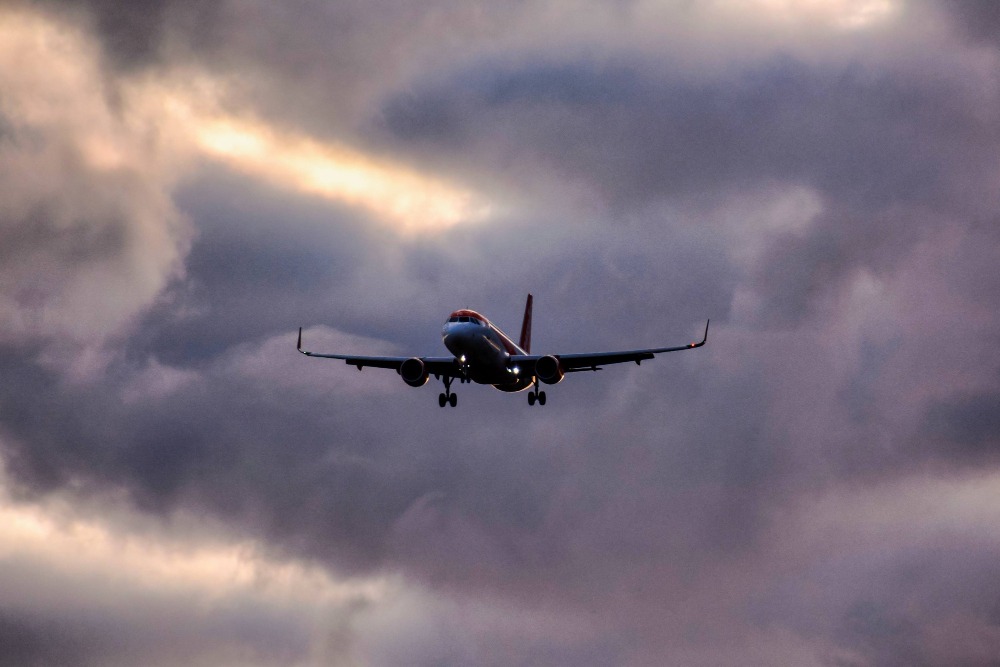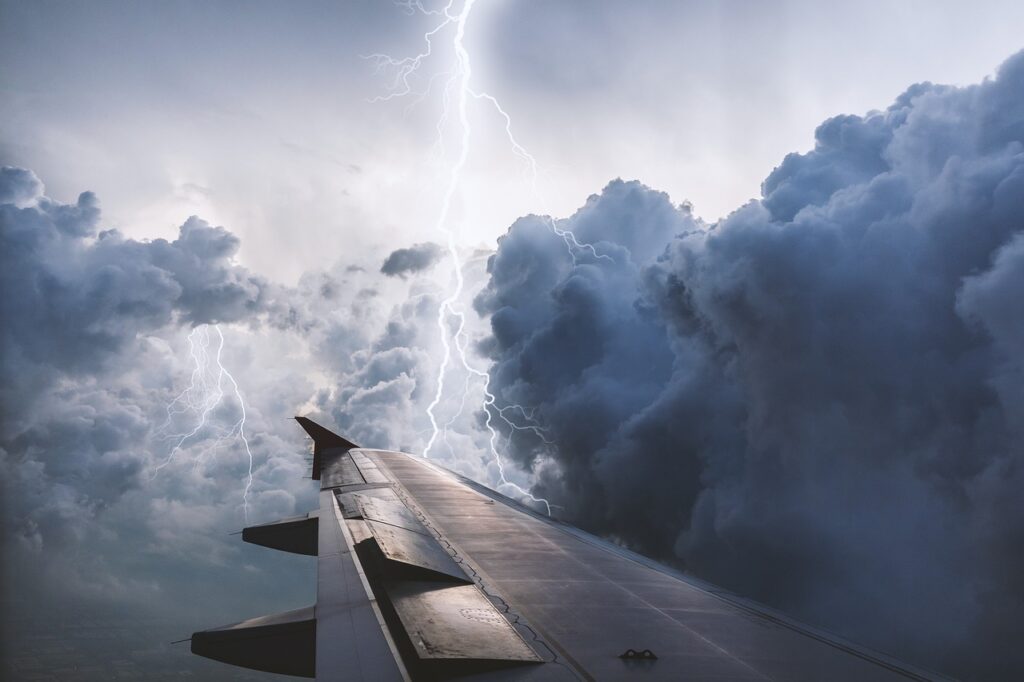According to the Federal Aviation Administration (FAA), weather was the biggest factor leading to flight delays of more than 15 minutes at 74.26%, besides others such as equipment, closed runways, and so on. Thunderstorms, in particular, are one such weather condition that can lead to flights getting delayed or even canceled.
This guide explores the different scenarios in which a flight could get canceled due to a thunderstorm, and what you should do in such a situation.
Can Planes Fly Safely Through Thunderstorms?

If you’re reading this, chances are you’re curious if planes can fly safely through thunderstorms. Well, thanks to modern technology, commercial planes are designed to be better able to manage such severe weather conditions.
Besides key design elements such as wing flex and the use of Weather Radar Systems, airlines are also required to meet stringent safety standards laid down by the FAA or the CAA (in the UK). Additionally, weather radar systems allow pilots to detect and avoid thunderstorms, thereby ensuring the safety of the passengers, crew, and the plane itself.
During a thunderstorm, pilots are also in constant communication with ATC to decide whether it’s safer to fly above or below a thunderstorm to avoid the downdrafts, lightning, and hail in the middle of it. So, to answer the question, yes, planes can safely navigate thunderstorms.
How Airlines Decide to Cancel Flights Due to Thunderstorms
When the airport and its vicinity are faced with a thunderstorm, airlines typically work with ATC to decide whether or not it’s safe to fly or if flights need to be delayed or canceled. Thunderstorms and severe weather are often classified as extraordinary circumstances, meaning that airlines may not be required to provide compensation for cancellations due to safety concerns. The decision rests on basic safety thresholds, such as wind speed and visibility. If a storm exceeds the maximum thresholds, a flight could be delayed or canceled.
Typically, crosswinds that exceed 30-35 kts or about 34-40 mph generally lead to take-offs and landings being prohibited. However, smaller aircraft are more susceptible to the effects of crosswinds when compared to bigger ones, besides other factors such as the length and condition of the runway, the pilot’s experience, and so on.
In terms of visibility, the FAA has established takeoff minimums for airports that are used by commercially-operated aircraft. However, at airports where these minimums are not established, the FAA-designed standard minimum for single and twin-engine planes is 1 statute mile (SM).
Besides collaborating with ATC, airlines also work with flight dispatchers, meteorologists, and pilots to assess whether the flight is safe for the passengers and crew on board. If a storm is fast-moving, for instance, airlines might decide that a delay is best. However, if a thunderstorm is slow-moving and poses immense risk, they may decide to cancel the flight.
What Makes Thunderstorms Dangerous for Air Travel?

There are various elements of a thunderstorm that can pose a danger to air travel, some of which are described below:
- Wind Speeds: Wind speeds severely affect a plane’s ability to fly during a thunderstorm. The faster the winds, the more dangerous it is for a plane.
- Wind Shear: Another factor to consider is wind shear, which refers to a sudden change in the direction or speed of the wind over a short distance.
- Downdrafts and Microbursts: Downdrafts and microbursts are downward winds that can cause a plane to suddenly lose altitude, which can be particularly dangerous to planes attempting to land on the runway. What adds to the danger is that wind speeds in microbursts can reach up to 100 mph, besides the potential for heavy rain which can severely affect visibility.
- Turbulence: Turbulence can also cause a great deal of danger to planes and their passengers, particularly if you’re closer to the eye of the storm. In July 2023, for instance, seven people were injured on a Hawaiian Airlines flight to Sydney, Australia, when the plane was buffeted by severe turbulence. Besides this, more than 20 people were injured on a Singapore Airlines flight hit by severe turbulence. Many of those injured were also being treated for spinal injuries.
- Lightning: When it comes to lightning strikes, modern aircraft are better able to deal with their risks. However, they can still lead to the need for safety checks, which in turn can lead to delays.
Pro Traveler’s Tip: If turbulence makes you anxious, book a seat near the wings—this part of the plane experiences less movement during rough air.
What Should You Do if Your Flight Gets Canceled Due to a Thunderstorm?
The probability of a flight being canceled due to a thunderstorm is minimal, but severe thunderstorms can always lead to such an outcome If your flight gets canceled due to a thunderstorm, there are a few things you can do. Some of these include:
- Confirm the Cancelation: Check the airline’s app or website to check your flight’s status and to confirm whether or not it’s been canceled.
- Contact the Airline: The next step is to contact the airline and ask them for the option to book yourself on an alternative flight.
- Know Your Rights: Know Your Rights: Passengers must be aware of their rights in case of a flight cancellation, including any potential support during weather-related disruptions. While compensation may not always be guaranteed, airlines often provide assistance like meals or accommodations. You can read more about your rights regarding bad weather flight compensation to understand what might apply in such cases.
- Plan for Accommodation: If your flight has been indefinitely canceled, you should look for accommodation options until you can book yourself on an alternative flight or until you can get a resolution from the airline.
- Check Travel Insurance: If you’ve purchased travel insurance, you should check if it covers expenses such as your accommodation, meals, and alternative bookings.
While thunderstorms don’t always cancel flights, severe weather can still cause disruptions. Staying informed and acting quickly can help minimize delays and ensure a smoother travel experience.
FAQ
Whether or not a plane can land during a thunderstorm will depend on the wind speeds and visibility, among other factors. Airlines actively communicate with air traffic control to decide the safest course of action in such situations.
There are several different kinds of thunderstorms, and they’re classified based on their severity. While severe thunderstorms present greater risks, pilots are trained to take the best course of action while closely communicating with air traffic control in the process.
Yes, modern aircraft are designed to safely fly in heavy rain, as it doesn’t pose any significant risks to a plane while it’s in the air. In most cases, it’s also safe for a plane to take off or land amid heavy rain.
